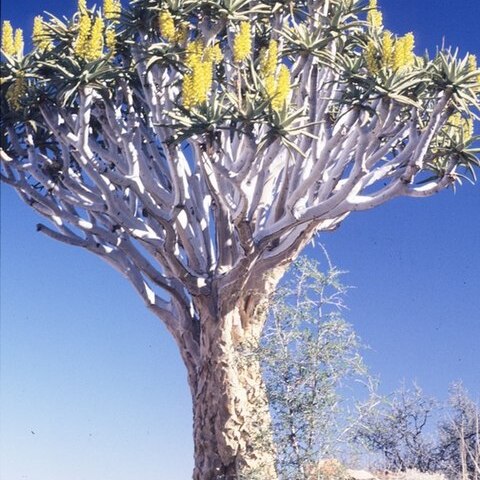Plants tall trees 6-9 met. high, the trunk 1 met. or more diam. at ground level, narrowing upwards, copiously and dichotomously branched mostly from about the middle. Leaves about 20, basally amplexicaul, densely rosulate, lanceolate-linear, 25-35 cm long, 5 cm broad at base, glaucous-green; upper surface flat to slightly canaliculate; lower surface convex; margins with an exceedingly narrow brownish-yellow edge, armed with deltoid teeth 1 mm long, of the same colour, the teeth gradually smaller upwards, obsolescent near apex. Inflorescence a branched panicle up to 30 cm tall from base of peduncle to apex of terminal raceme, dichotomously 3-4-5-branched from low down. Racemes broadly cylindric, slightly acuminate, the terminal about 15 cm long, 9 cm diam., the buds yellow, greenish tipped, the open flowers lemon-yellow to bright canary-yellow. Bracts 5-7 mm long, from a 3 mm broad base narrowly acuminate, 3-nerved. Pedicels 5-10 mm long, green. Perianth bright canary-yellow, cylindric-ventricose, averaging 33 mm long, thick and rather fleshy, 14 mm diam. at the middle, rounded at base and shortly stipitate; outer segments free for 25 mm (tube 8 mm), with about 5 obscure nerves confluent at apex, the apices sub-acute, slightly spreading; inner segments free, not dorsally adnate to the outer, about 3 mm longer than the outer, white, with 3 congested greenish nerves forming a keel, the apices more obtuse, more spreading than the outer. Filaments much flattened, the 3 inner narrower and lengthening in advance of the 3 outer, lemon within the perianth, the 15 mm exserted portion turning orange. Anthers 5 mm long, the 3 inner and 3 outer in turn exserted 12-15 mm Stigma at length exserted 15 mm. Ovary pale brown, 8 mm long, 4.5 mm diam., finely 6-grooved. Capsule 30 mm long, 18 mm diam. at the middle, distinctly stipitate, and for some time supported by the cup-shaped basal remains of the dried perianth.
More
Trees 3-9 m tall, with many dichotomous branches. Leaves 10-20 per rosette, lorate-lanceolate, 200-350 x 20-50 mm, slightly biconvex to shallowly channelled, glaucous green. Inflorescence robust, erect, 3-5-branched, 150-300 mm tall; bracts deltoid-cirrhous, 4.0-8.0 x 0.5-3.0 mm, 1-3-nerved. Flowers lemon-yellow to canary-yellow, 27-40 mm long, cylindric-ventricose; outer segments connate in basal third, inner segments free; pedicels 5-10 mm long. Anthers exserted 1-20 mm. Ovary 6-9 x 3-5 mm, pale brown; style exserted 9-15 mm. Fruit 30-45 x 15-20 mm, yellow-ochre. Seeds ochre-grey, ±16.5 x 9.0 x 3.0 mm including a broad wing.
Tree aloe, 3-9 m tall. Branches smooth, repeatedly forked, often forming densely rounded crowns; bark on trunk forms large golden-brown scales with razor-sharp edges. Leaves blue-green, narrow, oblong, ± 300 mm long, 50 mm wide at base, ranked in vertical rows in juvenile plants, gradually becoming spirally arranged in terminal rosettes in older plants, margins with inconspicuous teeth. Flowers in short, erect, branched racemes, bright yellow, comparatively large and short, swollen in middle.


